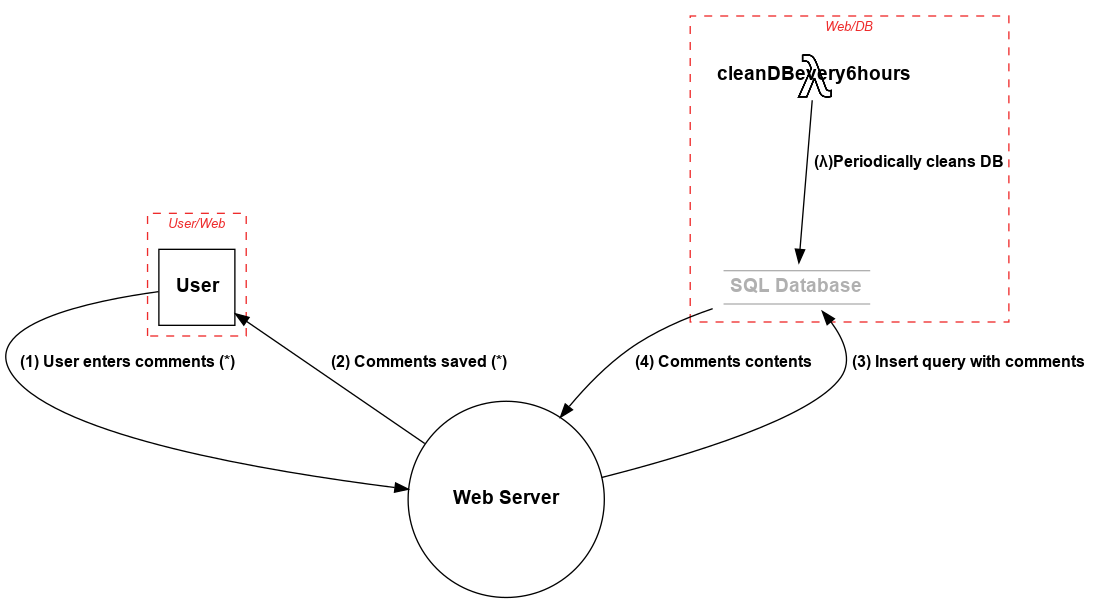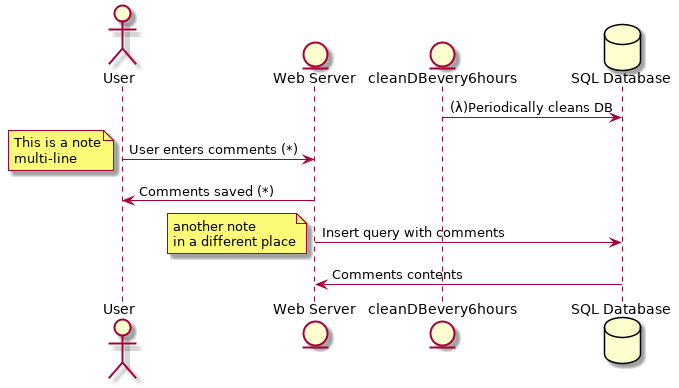Define your system in Python using the elements and properties described in the pytm framework. Based on your definition, pytm can generate, a Data Flow Diagram (DFD), a Sequence Diagram and most important of all, threats to your system.
- Linux/MacOS
- Python 3.x
- Graphviz package
- Java (OpenJDK 10 or 11)
- plantuml.jar
tm.py [-h] [--debug] [--dfd] [--report REPORT] [--exclude EXCLUDE] [--seq] [--list] [--describe DESCRIBE]
optional arguments:
-h, --help show this help message and exit
--debug print debug messages
--dfd output DFD (default)
--report REPORT output report using the named template file (sample template file is under docs/template.md)
--exclude EXCLUDE specify threat IDs to be ignored
--seq output sequential diagram
--list list all available threats
--describe DESCRIBE describe the properties available for a given element
Currently available elements are: TM, Element, Server, ExternalEntity, Datastore, Actor, Process, SetOfProcesses, Dataflow, Boundary and Lambda.
The available properties of an element can be listed by using --describe followed by the name of an element:
(pytm) ➜ pytm git:(master) ✗ ./tm.py --describe Element
Element class attributes:
OS
definesConnectionTimeout default: False
description
handlesResources default: False
implementsAuthenticationScheme default: False
implementsNonce default: False
inBoundary
inScope Is the element in scope of the threat model, default: True
isAdmin default: False
isHardened default: False
name required
onAWS default: False
The following is a sample tm.py file that describes a simple application where a User logs into the application
and posts comments on the app. The app server stores those comments into the database. There is an AWS Lambda
that periodically cleans the Database.
#!/usr/bin/env python3
from pytm.pytm import TM, Server, Datastore, Dataflow, Boundary, Actor, Lambda
tm = TM("my test tm")
tm.description = "another test tm"
tm.isOrdered = True
User_Web = Boundary("User/Web")
Web_DB = Boundary("Web/DB")
user = Actor("User")
user.inBoundary = User_Web
web = Server("Web Server")
web.OS = "CloudOS"
web.isHardened = True
db = Datastore("SQL Database (*)")
db.OS = "CentOS"
db.isHardened = False
db.inBoundary = Web_DB
db.isSql = True
db.inScope = False
my_lambda = Lambda("cleanDBevery6hours")
my_lambda.hasAccessControl = True
my_lambda.inBoundary = Web_DB
my_lambda_to_db = Dataflow(my_lambda, db, "(λ)Periodically cleans DB")
my_lambda_to_db.protocol = "SQL"
my_lambda_to_db.dstPort = 3306
user_to_web = Dataflow(user, web, "User enters comments (*)")
user_to_web.protocol = "HTTP"
user_to_web.dstPort = 80
user_to_web.data = 'Comments in HTML or Markdown'
web_to_user = Dataflow(web, user, "Comments saved (*)")
web_to_user.protocol = "HTTP"
web_to_user.data = 'Ack of saving or error message, in JSON'
web_to_db = Dataflow(web, db, "Insert query with comments")
web_to_db.protocol = "MySQL"
web_to_db.dstPort = 3306
web_to_db.data = 'MySQL insert statement, all literals'
db_to_web = Dataflow(db, web, "Comments contents")
db_to_web.protocol = "MySQL"
db_to_web.data = 'Results of insert op'
tm.process()Diagrams are output as Dot and PlantUML.
When --dfd argument is passed to the above tm.py file it generates output to stdout, which is fed to Graphviz's dot to generate the Data Flow Diagram:
tm.py --dfd | dot -Tpng -o sample.png
Generates this diagram:
The following command generates a Sequence diagram.
tm.py --seq | java -Djava.awt.headless=true -jar plantuml.jar -tpng -pipe > seq.png
Generates this diagram:
The diagrams and findings can be included in the template to create a final report:
tm.py --report docs/template.md | pandoc -f markdown -t html > report.html
The templating format used in the report template is very simple:
# Threat Model Sample
***
## System Description
{tm.description}
## Dataflow Diagram

## Dataflows
Name|From|To |Data|Protocol|Port
----|----|---|----|--------|----
{dataflows:repeat:{{item.name}}|{{item.source.name}}|{{item.sink.name}}|{{item.data}}|{{item.protocol}}|{{item.dstPort}}
}
## Findings
{findings:repeat:* {{item.description}} on element "{{item.target}}"
}
To group findings by elements, use a more advanced, nested loop:
## Findings
{elements:repeat:{{item.findings:if:
### {{item.name}}
{{item.findings:repeat:
**Threat**: {{{{item.id}}}} - {{{{item.description}}}}
**Severity**: {{{{item.severity}}}}
**Mitigations**: {{{{item.mitigations}}}}
**References**: {{{{item.references}}}}
}}}}}
All items inside a loop must be escaped, doubling the braces, so {item.name} becomes {{item.name}}.
The example above uses two nested loops, so items in the inner loop must be escaped twice, that's why they're using four braces.
For the security practitioner, you may supply your own threats file by setting TM.threatsFile. It should contain entries like:
{
"SID":"INP01",
"target": ["Lambda","Process"],
"description": "Buffer Overflow via Environment Variables",
"details": "This attack pattern involves causing a buffer overflow through manipulation of environment variables. Once the attacker finds that they can modify an environment variable, they may try to overflow associated buffers. This attack leverages implicit trust often placed in environment variables.",
"Likelihood Of Attack": "High",
"severity": "High",
"condition": "target.usesEnvironmentVariables is True and target.sanitizesInput is False and target.checksInputBounds is False",
"prerequisites": "The application uses environment variables.An environment variable exposed to the user is vulnerable to a buffer overflow.The vulnerable environment variable uses untrusted data.Tainted data used in the environment variables is not properly validated. For instance boundary checking is not done before copying the input data to a buffer.",
"mitigations": "Do not expose environment variable to the user.Do not use untrusted data in your environment variables. Use a language or compiler that performs automatic bounds checking. There are tools such as Sharefuzz [R.10.3] which is an environment variable fuzzer for Unix that support loading a shared library. You can use Sharefuzz to determine if you are exposing an environment variable vulnerable to buffer overflow.",
"example": "Attack Example: Buffer Overflow in $HOME A buffer overflow in sccw allows local users to gain root access via the $HOME environmental variable. Attack Example: Buffer Overflow in TERM A buffer overflow in the rlogin program involves its consumption of the TERM environmental variable.",
"references": "https://capec.mitre.org/data/definitions/10.html, CVE-1999-0906, CVE-1999-0046, http://cwe.mitre.org/data/definitions/120.html, http://cwe.mitre.org/data/definitions/119.html, http://cwe.mitre.org/data/definitions/680.html"
}The target field lists classes of model elements to match this threat against.
Those can be assets, like: Actor, Datastore, Server, Process, SetOfProcesses, ExternalEntity,
Lambda or Element, which is the base class and matches any. It can also be a Dataflow that connects two assets.
All other fields (except condition) are available for display and can be used in the template
to list findings in the final report.
WARNING
The
threats.jsonfile contains strings that run througheval(). Make sure the file has correct permissions or risk having an attacker change the strings and cause you to run code on their behalf.
The logic lives in the condition, where members of target can be logically evaluated.
Returning a true means the rule generates a finding, otherwise, it is not a finding.
Condition may compare attributes of target and also call one of these methods:
target.oneOf(class, ...)whereclassis one or more: Actor, Datastore, Server, Process, SetOfProcesses, ExternalEntity, Lambda or Dataflow,target.crosses(Boundary),target.enters(Boundary),target.exits(Boundary),target.inside(Boundary).
If target is a Dataflow, remember you can access target.source and/or target.sink along with other attributes.
Conditions on assets can analyze all incoming and outgoing Dataflows by inspecting
the target.input and target.output attributes. For example, to match a threat only against
servers with incoming traffic, use any(target.inputs). A more advanced example,
matching elements connecting to SQL datastores, would be any(f.sink.oneOf(Datastore) and f.sink.isSQL for f in target.outputs).
INP01 - Buffer Overflow via Environment Variables
INP02 - Overflow Buffers
INP03 - Server Side Include (SSI) Injection
CR01 - Session Sidejacking
INP04 - HTTP Request Splitting
CR02 - Cross Site Tracing
INP05 - Command Line Execution through SQL Injection
INP06 - SQL Injection through SOAP Parameter Tampering
SC01 - JSON Hijacking (aka JavaScript Hijacking)
LB01 - API Manipulation
AA01 - Authentication Abuse/ByPass
DS01 - Excavation
DE01 - Interception
DE02 - Double Encoding
API01 - Exploit Test APIs
AC01 - Privilege Abuse
INP07 - Buffer Manipulation
AC02 - Shared Data Manipulation
DO01 - Flooding
HA01 - Path Traversal
AC03 - Subverting Environment Variable Values
DO02 - Excessive Allocation
DS02 - Try All Common Switches
INP08 - Format String Injection
INP09 - LDAP Injection
INP10 - Parameter Injection
INP11 - Relative Path Traversal
INP12 - Client-side Injection-induced Buffer Overflow
AC04 - XML Schema Poisoning
DO03 - XML Ping of the Death
AC05 - Content Spoofing
INP13 - Command Delimiters
INP14 - Input Data Manipulation
DE03 - Sniffing Attacks
CR03 - Dictionary-based Password Attack
API02 - Exploit Script-Based APIs
HA02 - White Box Reverse Engineering
DS03 - Footprinting
AC06 - Using Malicious Files
HA03 - Web Application Fingerprinting
SC02 - XSS Targeting Non-Script Elements
AC07 - Exploiting Incorrectly Configured Access Control Security Levels
INP15 - IMAP/SMTP Command Injection
HA04 - Reverse Engineering
SC03 - Embedding Scripts within Scripts
INP16 - PHP Remote File Inclusion
AA02 - Principal Spoof
CR04 - Session Credential Falsification through Forging
DO04 - XML Entity Expansion
DS04 - XSS Targeting Error Pages
SC04 - XSS Using Alternate Syntax
CR05 - Encryption Brute Forcing
AC08 - Manipulate Registry Information
DS05 - Lifting Sensitive Data Embedded in Cache
SC05 - Removing Important Client Functionality
INP17 - XSS Using MIME Type Mismatch
AA03 - Exploitation of Trusted Credentials
AC09 - Functionality Misuse
INP18 - Fuzzing and observing application log data/errors for application mapping
CR06 - Communication Channel Manipulation
AC10 - Exploiting Incorrectly Configured SSL
CR07 - XML Routing Detour Attacks
AA04 - Exploiting Trust in Client
CR08 - Client-Server Protocol Manipulation
INP19 - XML External Entities Blowup
INP20 - iFrame Overlay
AC11 - Session Credential Falsification through Manipulation
INP21 - DTD Injection
INP22 - XML Attribute Blowup
INP23 - File Content Injection
DO05 - XML Nested Payloads
AC12 - Privilege Escalation
AC13 - Hijacking a privileged process
AC14 - Catching exception throw/signal from privileged block
INP24 - Filter Failure through Buffer Overflow
INP25 - Resource Injection
INP26 - Code Injection
INP27 - XSS Targeting HTML Attributes
INP28 - XSS Targeting URI Placeholders
INP29 - XSS Using Doubled Characters
INP30 - XSS Using Invalid Characters
INP31 - Command Injection
INP32 - XML Injection
INP33 - Remote Code Inclusion
INP34 - SOAP Array Overflow
INP35 - Leverage Alternate Encoding
DE04 - Audit Log Manipulation
AC15 - Schema Poisoning
INP36 - HTTP Response Smuggling
INP37 - HTTP Request Smuggling
INP38 - DOM-Based XSS
AC16 - Session Credential Falsification through Prediction
INP39 - Reflected XSS
INP40 - Stored XSS
AC17 - Session Hijacking - ServerSide
AC18 - Session Hijacking - ClientSide
INP41 - Argument Injection
AC19 - Reusing Session IDs (aka Session Replay) - ServerSide
AC20 - Reusing Session IDs (aka Session Replay) - ClientSide
AC21 - Cross Site Request Forgery

